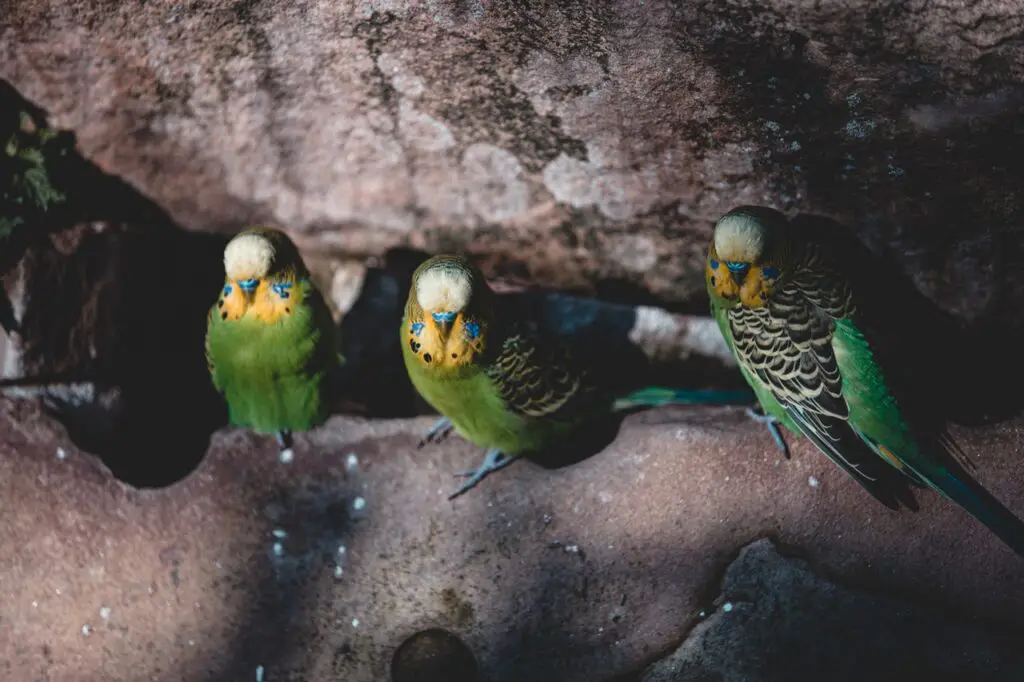While most budgies can be released into the wild safely, the situation isn’t always as simple as setting your budgie free. Luckily, there are a few tips you can use to set your budgie free and keep it safe. Providing a safe environment is essential, but you should also be aware of your surroundings and be mindful of any unusual noises your budgie may make. Make sure your budgie has access to water and food and can return home when it needs to rest.
Exhaustion of A Stray Budgie
There is nothing worse than finding a stray budgie. These curious birds are often playful and like to play outside their cage. Sometimes they can fly out of an open door or window or out of a chimney flue. Depending on how far they’ve gotten into a cage, they may even come and land on your shoulder or a door full of treats. You can do a few things to prevent them from flying off.
One of the first things to do is ensure the bird has plenty of food. They might have been tamed with pellets and grains if the bird was captive. However, a stray budgie may still be searching for a meal, so try to provide them with some fruits and vegetables. The bird’s health depends on a healthy diet.
The next step is to catch the errant budgie. A stray budgie may have a parasite or diarrhea, making it dangerous for humans. You can try to lure the bird back with food, but you’ll have to use your cunning if it doesn’t come back. Ensure the bird is well-fed and has a safe place to sleep.
Depending on the illness, a sick budgie can live for one to three days. While they usually recover, they may need to be put down if their condition is very severe. It is best to visit a vet if you’re unsure whether your bird has any illnesses. It’s important to note that some budgies are not as susceptible to illnesses as other animals, and you must take them to a vet as soon as possible.
As winter sets in, the chances of survival are decreasing. Temperatures drop below zero degrees Celcius in the winter. A budgie left outdoors in a cage will not likely survive the cold for very long. But if it’s too cold, it may succumb to heat exhaustion and respiratory problems. If you’re lucky, you can find a budgie in a sunny window and bring it home.

Finding a Budgie in The Wild
There are over five million budgies in the wild today. They are typically smaller than their captive counterparts, and they are nomadic. They are a native of Australia, and their breeding range includes dry, open landscapes. Find a budgie in the wild and enjoy the company of these colorful birds! Find out why they are so popular as pets! And don’t worry if you cannot spot your budgie in the wild – there are many!
Budgies are very social and take great care to groom each other. They are monogamous and breed throughout the year. Male budgies usually nest within a few meters of each other, and females lay four to eight eggs. The eggs hatch after 18 days, and the chicks leave their nest 35 days later. Then, they’re ready to mate again. If you’re looking for a new pet, look for a pair already paired.
A budgie in the wild will have many friends. Often, a budgie will migrate in flocks with many other birds. Flocks of budgies can number in the thousands. These social birds are very social and will remain docile if housed together. A lone budgie is a perfect pet for those who love socializing with their budgies.
If you’re lucky enough to find a budgie in the wild, there are several ways to catch it. One method involves setting up a box on a stick and using a long piece of string to trap it. The box can be propped up on the stick, leaving a gap in the middle. You can place bait underneath the box, such as a butterfly feeder or millet seed. If the budgie comes under the box/cage, it will fall under the bait and get trapped.
Whether you find a budgie in the wild, you must be careful when taking it out. Budgies are not used to being outside their cage and are highly vulnerable to several predators, such as cats. A budgie unfamiliar with the outdoors can get confused and be prone to starvation. When it lands, it can get attacked by predators, so patience is essential.

Providing a Warm Environment for A Budgie
Unlike other birds, budgies are sensitive to cold weather and require a constant, stable temperature, and the temperature must remain between sixty and seventy degrees Fahrenheit. Even though they are adapted to the temperature conditions of central Australia, extreme temperature fluctuations are unaccepted by budgies. A temperature of sixty to seventy degrees F is ideal for domesticated birds.
While extreme temperature changes are not as harmful to humans, they are bad for budgies. Extreme temperatures will cause discomfort, and their feathers will lose their ability to maintain body temperature. Fortunately, there are a variety of budgies that can tolerate moderate temperature changes. If you find your budgie is struggling with overheating, try moving it to a cooler room until the temperature is more stable.
A budgie is a tropical bird and should not be placed in a room with extreme temperature fluctuations. Temperatures should remain between sixty and seventy degrees Fahrenheit. This temperature range is ideal for budgies; they should never be subjected to extreme temperatures or cold climates. These birds can become very nervous and exhibit a range of behaviors if the temperature changes by more than twenty degrees.
In addition to temperature management, budgies need shelter during the winter months. A small birdhouse can protect them from cold wind and stabilize their body temperature. For best results, buy a cage with several heating options. If you’re unsure, try out a few! If you doubt whether or not your budgie is comfortable in the winter, it’s best to find out first.
In addition to maintaining a consistent temperature, budgies must maintain a regular schedule. They need at least 12 hours of sleep each day. Covering their cage at night prevents night fright and helps them adjust to a routine. Eventually, your budgie may even ask for a cover at night. If your budgie does get cold, it will puff its feathers and stand on one leg at a time. However, prolonged exposure to cold temperatures can harm budgies and lead to listlessness. In addition, budgies may start flapping their wings more often to try and warm up.
